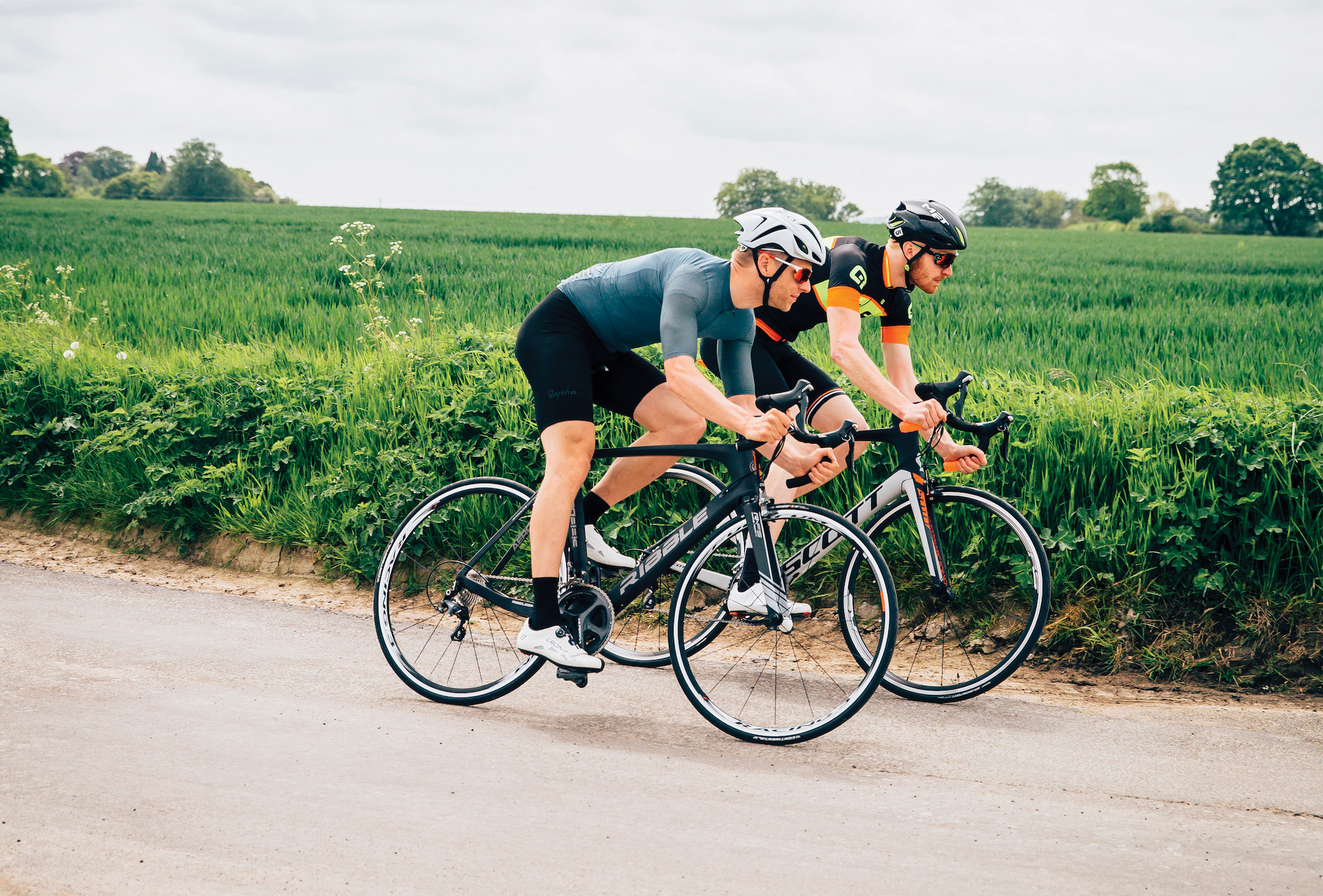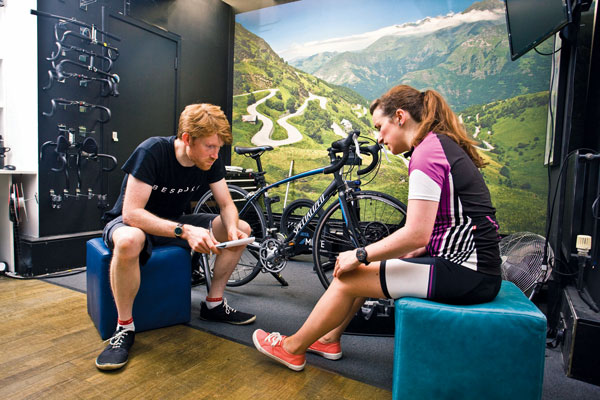Handlebar reach: how to get it right (video)
How can you check that your handlebar reach is correctly dialled in? Our experts will help you nail one of the most important areas of bike fit

Your handlebar reach is the distance you have to stretch (or ‘reach’) to get your hands on the bars, with your arms, glutes and lower back in a comfortable riding position.
It is dictated by a number of things. Top of that list is the rider’s saddle position, and the flexibility of that rider. As with all elements of a bike fit, getting your handlebar reach right is hard to perform in isolation, but we’re here to give you the science and practical advice you need to get started.
So what is handlebar reach?
In terms of road bike geometry, the ‘reach’ is a measurement that can be used to ascertain what frame size a rider requires. If you take a vertical line from the bottom bracket up through the top tube (the frame’s ‘stack’), and a further vertical line from the centre of the top of the head tube, your reach measurement is the distance, in a horizontal line, between the two.
Stack and reach are used by many bike manufacturers as a clearer alternative to effective top tube measurements to measure up riders for the correct frame size. Of course, depending on the size of the frame, and variables such as top tube angle, the reach can change significantly.
From a practical point of view, this measurement gives you a ballpark figure for frame size, but to make sure your riding position is least likely to cause you discomfort, the distance to the bars and controls is obviously a factor in getting it fine tuned.
Everything’s connected

Getting a bike fit spot-on requires a skilled mind and a trained eye (and often a fair amount of computer software). Of course, the locations of your bike’s contact points (saddle, pedals and bars) are entirely interdependent.
Nick Smith, of Core Cycling Solutions (corecyclingsolutions.com) is a Retul bike-fitter and coach. “If you lower or heighten the front end of the bike, or extend or shorten the reach by changing the stem length, you will change the rider’s back and shoulder angle,” he explains. “For instance, if you lower and extend the reach, you will have a more aggressive back angle and a longer arm reach.”
The latest race content, interviews, features, reviews and expert buying guides, direct to your inbox!
But there’s something you need to get bang-on before you start — your saddle height and position. Smith continues: “If you move your reach or stem height around, your saddle might need to be moved to compensate for this.
“However, it is your legs you ride with, so you should always look at this part of the fit first, and move the handlebars and stem around what has already been done to your saddle position.”
Don’t overreach yourself
Adjusting reach in different ways, at its most extreme, can affect bike handling, as Smith explains: “If we look at a mountain bike or cyclo-cross set-up, you can see that the handlebars are a lot closer to the rider, and the stems shorter, which provides more control around those tight corners.”
At the opposite end of the spectrum, and dependent upon the flexibility of the rider, he adds: “If your core and upper body strength is good, you will be able to have a very good aero position without suffering from a lack of control — within reason. Obviously, if you’re assuming the Graham Obree ‘Superman’ position, your bike’s handling is going to be very poor indeed.”
Fit for purpose

So what’s the ideal riding position for you? Is bolt upright the way to go, or is a lower, more aerodynamic position what you need to save watts? The answer, as Scott Tomkinson of Kernow Physio (kernowphysio.co.uk) explains, isn’t cut and dried.
“The reach will depend on each rider’s personal body shape, and limb length in addition to the range of movement in their lower back,” he explains. “And flexibility plays a massive part in the ability to reach and maintain comfort on a bike. You see pros on the telly with a slammed, long stem, which looks great. But apply that position to people who predominantly work in offices and spend much of the day sitting at desks, and their inherent muscle tightness will come into play.
“The important point to make is that reach depends not only on personal body geometry, but also your daily activities and profession, and ability to stabilise their lower back with appropriate muscle strength.”
Smith echoes this sentiment, suggesting: “Every rider is different and that is why a Retul bike-fit always includes a detailed physical assessment. The most comfortable position is entirely dependent on the rider’s flexibility, core and upper-body strength.”
Clues your reach is wrong

Poor bike posture can lead to all manner of aches and pains, or even a physical inability to control your bike properly. If you’re suffering from any of these, the source might be reach-related.
Sore neck/shoulders
If you ride with your arms outstretched, with insufficient bend, you’re putting pressure on the muscles in your neck and shoulders. Beyond this, you won’t be engaging your core muscles efficiently.
Lower back pain
Lower back pain is often caused by hyper-extension as a result of overreaching, and can be alleviated by performing hamstring and core exercises to strengthen and add flexibility.
Saddle soreness
If your seat is too high, the flexibility of your hamstrings becomes crucial. Once the limit of their flexibility is reached, your hips will begin to rock, causing chafing to the saddle area. You may find it useful to raise the stem on your steering tube to put less demand on the hamstrings and lower back. If your reach is too long, you may be rolling your pelvis forward onto the soft tissues at the front of your groin to stretch for the bars.
Pins and needles in hands
Exacerbated by vibration from the road; excessive pressure on your hands — e.g. by compensating for a long stem by moving the saddle forward — can cause wrist pain or numbness along the ulnar nerve that runs through your wrist and the outer edge of your hand.
Can’t reach the drops comfortably
If you’re unable to extend your reach to put your hands on the drops, chances are you’re already reaching too far in your normal riding position. Shortening your stem or raising your bars could be an option.
Top tips
1. If you can avoid it, don’t compensate by moving your saddle; try a different length stem instead.
2. Aim for a 90-degree flexion in your upper arm from your torso; straight arms are a one-way ticket to discomfort, and possible injury.
3. Get a friend to check your back is at roughly a 45-degree angle to your top tube.
4. Make it personal. If you’re a flexible racer, you might be able to go low and long; if you just want a comfy position, aero isn’t the be-all and end-all.
Your flexible friend
While we’ve identified underlying physiological factors that can determine your ideal reach, there are ways to adapt and improve flexibility, specifically in the hamstrings and lower back.
Tomkinson elaborates: “Cycling teaches you to move in only one plane repeatedly. Core strength is valuable in carrying out those repeated movements, but unless you perform a regular functional strength routine, this can lead to muscle imbalances in your back, legs and core, which may lead to injury.
“More importantly, it leads to a reduction in performance, as you are then no longer able to support yourself on the bike when applying power. A stable engine is a fast engine. So in terms of things a rider can do at home in addition to stretches, strength work using their own body weight alone to functionally strengthen their body and improve performance is key.”
Position v efficiency

Tomkinson touches upon a key consideration in discussing flexibility — performance. Smith takes up the subject: “Yes, a lower position allows less mass of the rider for the air to hit, making a rider more aero. However, this doesn’t make them quicker, as their power could be affected by this.
“A client of mine came in a few months ago. We couldn’t put him in a very low position, as his flexibility and other issues wouldn’t allow it. All the same, he did his first race a couple of weeks later and won. There would have been other riders a lot more aero than him, though not more efficient.”
Of course, most of us aren’t getting our reach sorted in order to be better racers. The nature of your cycling is going to have a major part to play in your set-up. Tomkinson advises: “A rider has to be clear about their goals. Are they just looking to lose weight, commute in comfort, or do they want to become a first-cat road racer? The answer to this question should determine their reach.
“A pro rider needs to be able to save energy at speed. Because they ride at 27mph-plus regularly, their bikes will be differently set up compared to Joe who commutes daily just to keep fit.
“In short, wind resistance is more important as a pro. Of course, pros know this, and many stretch and do core work to maintain their long, low positions.”
Do you need a full bike-fit?

You’ll have a good idea that your reach is wrong if you start to experience one of a number of aches and pains, specifically in the neck, shoulders or lower back (see ‘Clues your reach is wrong’). But is it necessary to go for a full bike-fit to get your reach dialled in?
“In an ideal world, if everyone’s bike fitted them perfectly, their bikes would be set up so their elbows have a slight bend when their hands are on the hoods, to absorb shock and bumps,” says Tomkinson. “If your arms are dead straight, this indicates the reach is too long and you may end up with neck pain as the shoulders and neck take the brunt of road buzz and bumps.
“Your shoulder or arm flexion in relation to your torso should also be around 90 degrees.”
However, unless you have a full-length mirror and a patient friend with a protractor, this will be hard to determine... Unless you have a professional fit.
Smith says: “Not everyone wants to spend £150-£225 on a top-end bike-fit, but when I started doing fitting, I obviously checked my position. My reach was too far, my back angle was way too low, I was too far forward in my saddle and a little too low in it.
“Not one of my cycling friends thought there was anything wrong with my position, and neither did I.”